27.6: Archimedes’ Principle - Buoyant Force
( \newcommand{\kernel}{\mathrm{null}\,}\)
When we place a piece of solid wood in water, the wood floats on the surface. The density of most woods is less than the density of water, and so the fact that wood floats does not seem so surprising. However, objects like ships constructed from materials like steel that are much denser than water also float. In both cases, when the floating object is at rest, there must be some other force that exactly balances the gravitational force. This balancing of forces also holds true for the fluid itself.
Consider a static fluid with uniform density ρf. Consider an arbitrary volume element of the fluid with volume V and mass mf=ρfV. The gravitational force acts on the volume element, pointing downwards, and is given by →F8=−ρfVgˆk, where ˆk is a unit vector pointing in the upward direction. The pressure on the surface is perpendicular to the surface (Figure 27.6). Therefore on each area element of the surface there is a perpendicular force on the surface. The pressure on the surface is perpendicular to the surface (Figure 27.6). Therefore on each area element of the surface there is a perpendicular force on the surface.
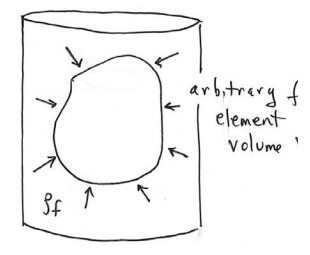
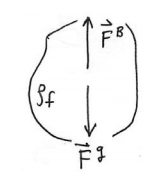
Let →FB denote the resultant force, called the buoyant force, on the surface of the volume element due to the pressure of the fluid. The buoyant force must exactly balance the gravitational force because the fluid is in static equilibrium (Figure 27.7), →0=→FB+→Fg=→FB−ρfVgˆk
We can now understand why when we place a stone in water it sinks. The density of the stone is greater than the density of the water, and so the buoyant force on the stone is less than the gravitational force on the stone and so it accelerates downward.
Place a uniform object of volume V and mass M with density ρo=M/V within a fluid. If the density of the object is less than the density of the fluid, ρ , the object will ρo<ρf float on the surface of the fluid. A portion of the object that is a beneath the surface, displaces a volume V1 of the fluid. The portion of the object that is above the surface displaces a volume V2=V−V1 of air (Figure 27.8).

Because the density of the air is much less that the density of the fluid, we can neglect the buoyant force of the air on the object.
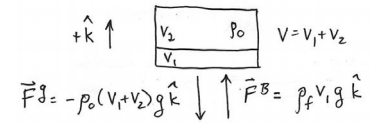
The buoyant force of the fluid on the object, →FBf,o=ρfV1gˆk must exactly balance the gravitational force on the object due to the earth, →Fge,ρ →0=→FBf,o+→Fge,o=ρfV1gˆk−ρoVgˆk=ρfV1gˆk−ρo(V1+V2)gˆk
Example 27.4 Archimedes' Principle: Floating Wood
Consider a beaker of uniform cross-sectional area A , filled with water of density ρw. When a rectangular block of wood of cross sectional area A2, height, and mass Mb is placed in the beaker, the bottom of the block is at an unknown depth z below the surface of the water. (a) How far below the surface z is the bottom of the block? (b) How much did the height of the water in the beaker rise when the block was placed in the beaker?
Solution
We neglect the buoyant force due to the displaced air because it is negligibly small compared to the buoyant force due to the water. The beaker, with the floating block of wood, is shown in Figure 27.10.
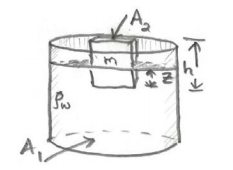
(a) The density of the block of wood is ρb=Mb/Vb=Mb/Abh The volume of the submerged portion of the wood is V1=Abz. The volume of the block above the surface is given by V2=Ab(h−z). We can apply Eq. (27.6.5), and determine that V2V1=Ab(h−z)Abz=(h−z)z=(ρw−ρb)ρb
(b) Before the block was placed in the beaker, the volume of water in the beaker is Vw=Asi, where si is the initial height of water in the beaker. When the wood is floating in the beaker, the volume of water in the beaker is equal to Vw=Asf−Abz, where sf is the final height of the water, in the beaker and Abz is the volume of the submerged portion of block. Because the volume of water has not changed Asi=Asf−Abz
Example 27.5 Rock Inside a Floating Salad Bowl
A rock of mass mr and density mr is placed in a salad bowl of mass mb. The salad bowl and rock float in a beaker of water of density ρw. The beaker has cross sectional area A. The rock is then removed from the bowl and allowed to sink to the bottom of the beaker. Does the water level rise or fall when the rock is dropped into the water?
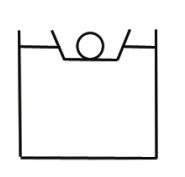
Solution
When the rock is placed in the floating salad bowl, a volume V of water is displaced. The buoyant force →FB=ρwVgˆk balances the gravitational force on the rock and salad bowl, (mr+mb)g=ρwVg=ρw(V1+V2)g
Example 27.6 Block Floating Between Oil and Water
A cubical block of wood, each side of length l = 10 cm , floats at the interface between air and water. The air is then replaced with d = 10 cm of oil that floats on top of the water.
a) Will the block rise or fall? Briefly explain your answer.
After the oil has been added and equilibrium established, the cubical block of wood floats at the interface between oil and water with its lower surface h=2.0×10−2m below the interface. The density of the oil is ρo=6.5×102kg⋅m−3. The density of water is ρw=1.0×103kg⋅m−3.
b) What is the density of the block of wood?
Solution
(a) The buoyant force is equal to the gravitational force on the block. Therefore ρbgV=ρwgV1+ρag(V−V1)
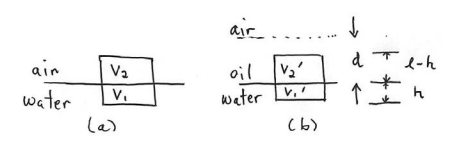
We now solve Eq. (27.6.14) for the volume of water displaced by the block
V1=(ρb−ρa)(ρw−ρa)V
ρbgV=ρwgV′1+ρσgV′2
where V′1 is the volume of water displaced by the block, V′2 is the volume of oil displaced by the block, V is the volume of the block, and ρb is the density of the block of wood. Because V′2=V−V′1, we rewrite Eq. (27.6.16) as
ρbgV=ρwgV′1+ρog(V−V′1)
V′1=(ρb−ρo)V(ρw−ρo)
(b) We use the fact that V′1=l2h,V′2=l2(l−h), and V=l3, in Eq. (27.6.16) and solve for the density of the block
ρb=ρwV′1+ρoV′2V=ρwl2h+ρol2(l−h)l3=(ρw−ρo)hl+ρo
We now substitute the given values from the problem statement and find that the density of the block is
ρb=((1.0×103kg⋅m−3)−(6.5×102kg⋅m−3))(2.0×10−2m)(1.0×10−1m)+(6.5×102kg⋅m−3)ρb=7.2×102kg⋅m−3
Because ρb>ρo, the above analysis is valid.

